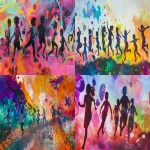Explore the Best AI Image Gallery

Where Imagination Meets Innovation: AIs Transformation of Graphic Design
The realm of graphic design is undergoing a profound metamorphosis, driven by the rapid advancements in artificial intelligence (AI). From generating stunning visuals to streamlining workflows, AI tools are reshaping the creative landscape and empowering designers with unprecedented capabilities. This blog post explores the multifaceted impact of AI on graphic design, dissecting its potential uses, ethical considerations, and future trends.
The Rise of AI-Powered Design Tools
A plethora of AI-powered design tools have emerged, offering a wide range of functionalities to enhance the creative process. These tools leverage machine learning algorithms to analyze vast datasets of images, typography, and design principles, enabling them to generate original artwork, create custom logos, design website layouts, and even produce marketing collateral.
Potential Applications in Graphic Design
- Logo and Branding Design: AI can assist in generating unique logo concepts based on specific brand guidelines and target audiences, streamlining the branding process.
- Image Generation and Editing: AI algorithms can create original images from textual descriptions (text-to-image generation), modify existing images with precision, and enhance image quality.
- Typography and Layout Design: AI can suggest font pairings, optimize text placement, and generate creative layouts for various design projects.
- Marketing Material Creation: AI tools can automate the design of brochures, flyers, social media graphics, and other marketing assets based on predefined templates and brand requirements.
Navigating the Ethical Landscape
While AI offers immense potential for graphic designers, it also raises ethical considerations that require careful attention:
- Copyright and Intellectual Property: The ownership and copyright of AI-generated designs remain a complex issue, requiring clear guidelines and legal frameworks.
- Bias and Fairness: AI algorithms can perpetuate biases present in the training data, potentially leading to discriminatory or unfair design outcomes. It is crucial to ensure that AI tools are trained on diverse and representative datasets to mitigate bias.
- Transparency and Explainability: The decision-making processes of AI algorithms can be opaque, making it difficult to understand how designs are generated. Transparency and explainability in AI systems are essential for building trust and accountability.
Future Trends in AI-Powered Graphic Design
The future of AI in graphic design is brimming with possibilities:
- Personalized Design Experiences: AI will enable the creation of highly personalized designs tailored to individual preferences and needs.
- Real-Time Collaboration: AI-powered tools will facilitate seamless collaboration between designers, clients, and stakeholders in real-time.
- Augmented Reality (AR) and Virtual Reality (VR) Integration: AI will play a pivotal role in integrating AR and VR into design workflows, creating immersive and interactive experiences.
- Continued Democratization of Design: AI will empower individuals with limited design experience to create professional-quality graphics, making design more accessible.
Conclusion
AI is revolutionizing the graphic design industry, empowering designers with innovative tools and capabilities. While ethical considerations must be addressed, the potential benefits of AI in design are immense. As AI technology continues to evolve, we can expect even more transformative applications that will shape the future of creative expression.







](https://images.ai-img.art/thumbnails/150/c48401bc3fad7ff7f2dbd37b894d3f53cb42d5072dfacb8bfdcdeeef28a29b04.webp)





















](https://images.ai-img.art/thumbnails/150/c2241c1eabdcb7b9a98be19a7e8d850b6cffe0e0c91c1ccda8dd807e2a96b187.webp)









](https://images.ai-img.art/thumbnails/150/09ccae5e68e2b6da6b5da87ef69f7eb09e80c99ca39ba886c5c3773cbb3b89ba.webp)





](https://images.ai-img.art/thumbnails/150/44b76c49c47b4c47f13eac7883c63827d3f89aa77fe64ce0cbecb9d3ce434499.webp)
](https://images.ai-img.art/thumbnails/150/47d44e177f427ea6b32f96ea225db96c5158850a0cf01d1bad93e45dd4594430.webp)


